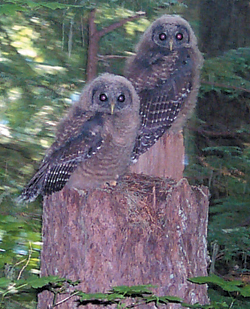After a decade of special protection for the northern spotted owl as a threatened species, new scientific data show the birds population is decreasing in Washington far faster than experts had expected. The decline could force the federal government to list the owl as an endangered species, which would complicate the already complicated politics of logging in the Northwest.
Im surprised that the population continues to decline, says Stan Sovern, lead biologist for the Cle Elum ranger district of the Okanogan and Wenatchee national forests, a long-standing stronghold for the bird. Sovern recently completed a study charting the owls population change since 1992, which is about the time many measures to protect the species were put into effect. His data show that the owls population has decreased by 64 percent from 1992 to 2002from 120 owls to 44 owls that make their homes in the dry forest on the east slope of the Cascade Range. Even more striking: Between 2001 and 2002, the owls population decreased by 22 percent.
Another study, by biologist Dale Herter, shows a drop of 66 percent over the same 10-year period in the Cascades from Interstate 90 to Mount Rainier. An analysis of data from across the owls range from northern California to Canada, performed by the Washington Department of Natural Resources, shows similar declines. For example, the Olympic Peninsula saw a decline of more than 10 percent per year, according to Scott Horton, a wildlife biologist with the state agency. Another study, of much of the Cascade Range in Washington by biologist Tracy Fleming, found a decline of 53 percent since 1992.
Those studies, along with those of other owl experts, were presented at a conference sponsored by the Washington chapter of the Wildlife Society in Port Townsend this week.
The Northwest Forest Plan has governed logging on federal land from northern California to Washington since 1994 and set aside reserves for the spotted owl. It projected a decrease in the birds population. Few experts, however, augured a decline of the magnitude seen in Washington. One commonly held assumption by the government in the early 1990s was that the bird would disappear at a rate of 1 percent a year. In addition, the U.S. Fish and Wildlife Service, which oversees the Endangered Species Act, said in the early 1990s that a 50 percent decline in 10 years would represent a worst-case scenario.
The worst case, based upon the new studies, has been reached, at least in parts of Washington.
That is distressing, says Joan Jewett, a spokesperson for the Fish and Wildlife Service in Portland. She says the agency is reviewing all current population studies of the owl, to be completed by years end. Then the agency will decide whether to keep listing the bird as a threatened species or to list it as endangered. Jewett says such dramatic population declines could prompt the agency to list the owl as an endangered species.
Changing the spotted owls status to endangered would enrage the timber industry, which already has cut operations on federal land in the Northwest. In April 2002, the Portland-based American Forest Resources Council, a timber-industry trade group, sued the Fish and Wildlife Service, forcing the agency to study the birds population. An official with the group argued last year that the owl should be delisted as a threatened species and be offered no special protection.
Sovern says that a dramatic population decline prevents the owl from successfully reproducing because its thinned population becomes so spread out that potential mates cannot find one another. Asked if the owl is now endangered, he says, I think its starting to look that way in the Cle Elum area.
Fleming has monitored owl populations for more than a decade. Sixteen years ago, I thought wed have a solution by now, he says, voicing frustration that now there is little mankind can do for the species.
Owl experts dont blame logging for the birds decline. Thats because there has been nowhere near the amount of logging permitted under the Northwest Forest Plan over the past decade. Instead, they ascribe the loss to incursions by the barred owl into spotted owl territory. The barred owl can outcompete the spotted owl for food and sometimes attacks the spotted owl. In addition, Fleming speculates that the West Nile virus could be hitting the spotted owl, since it is already affecting owls in the eastern United States.
Still, further protection given to the owl could snarl logging plans on both public and private land in the Northwest. For example, loggers would be unable to apply for permits to cut trees in owl territory, which is occasionally allowed under the owls current threatened status.








